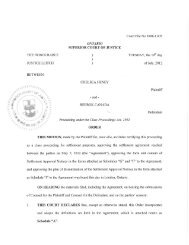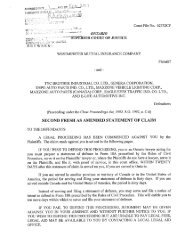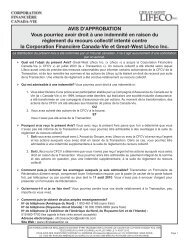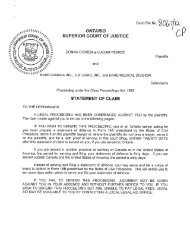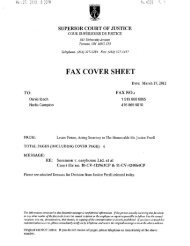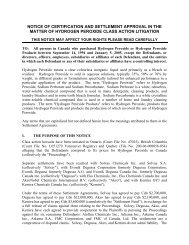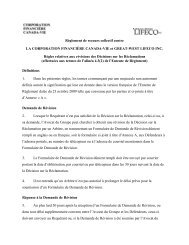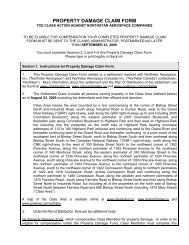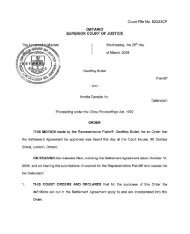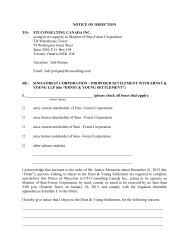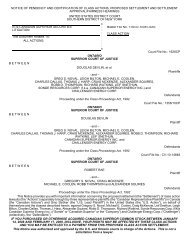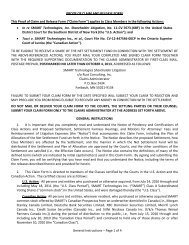Gariepy v. Shell Oil Co. - Classaction.ca
Gariepy v. Shell Oil Co. - Classaction.ca
Gariepy v. Shell Oil Co. - Classaction.ca
You also want an ePaper? Increase the reach of your titles
YUMPU automatically turns print PDFs into web optimized ePapers that Google loves.
completely suitable material from which to manufacture potable water pipes. Dr. Wiles expressesthe view that from the polybutylene plumbing systems he has examined, only rarely is thereevidence of oxidation and, where there is, it is "almost never enough to have <strong>ca</strong>used a pipe to failprematurely". Dr. Wiles says that, of the half dozen or so PB pipe failures due to oxidation he hadseen, the failures had occurred as a result of mishandling. Other pipe holes or leaks he observedusually occurred be<strong>ca</strong>use, among other things, the pipe was kinked or excessively bent or flattened,was punctured, was exposed to direct sunlight or was improperly extruded in one of a number ofways. 17 Celanese's principal expert is Richard R. Geoffroy. Mr. Geoffroy is a consultant whospecializes in the study and analysis of polymers. He has worked in the plastics industry for manyyears. He has developed extensive knowledge of, and experience with, all types of polymersincluding acetal copolymers such as Celcon. Mr. Geoffroy also disagrees with the theories andconclusions of the plaintiffs' experts. Mr. Geoffroy notes that the plaintiffs' theory and conclusionsare inconsistent with the fact that Celcon is used in numerous other appli<strong>ca</strong>tions where it is exposedcontinuously to chlorinated drinking water and where there have been no signifi<strong>ca</strong>nt failures.Likewise, Mr. Geoffroy notes that the plaintiffs' experts admit that premature leaks in polybutyleneplumbing may be <strong>ca</strong>used by a variety of different factors, such as installation errors, which havenothing to do with the alleged degradation of the raw materials. The plaintiffs chose not to crossexamineMr. Geoffroy on his affidavit. 18 All PB plumbing systems in Ontario are installed pursuant to the Ontario Building <strong>Co</strong>de. The<strong>Co</strong>de provides standards for the proper support of the piping, proper support of the fixtures, and theproper alignment of the piping to avoid strain. It also states that the piping shall not be bent or pulledafter it is joined, that hangers shall not compress, cut or abrade the pipe. The <strong>Co</strong>de provides that aplumbing system shall withstand certain tests. It states that "... potable water systems shall bedesigned, fabri<strong>ca</strong>ted and installed in accordance with good engineering practice ...". A plumbinginspector must verify that the entire polybutylene plumbing system has been installed pursuant tothe <strong>Co</strong>de requirements prior to approving the installation. 19 There is also disagreement over the likely size of the proposed class. The plaintiffs estimatethat the class will consist of thousands of Ontario homeowners. They say that over 300 potentialOntario class members have contacted their counsel with respect to this litigation and thatapproximately one third of those people have experienced leaks in their PB plumbing systems. Theplaintiffs also say that as of April 2000, class counsel in British <strong>Co</strong>lumbia (where it is said that therehas been far more extensive publicity) had been contacted by over 4,000 potential class membersresident in British <strong>Co</strong>lumbia who have polybutylene plumbing and/or heating systems. The plaintiffsalso rely on a report done in 1997 by ARA <strong>Co</strong>nsulting Group Inc., a major Canadian consulting firm,which conducted an analysis of the use of PB plumbing systems for indoor plumbing use throughoutCanada. The ARA report estimated that, as of 1996, over 700,000 homes in Canada had beenplumbed with PB plumbing systems. In addition, the plaintiffs' counsel have considered the numberof mobile homes with polybutylene plumbing systems in Ontario. Plaintiffs' counsel estimate that,as of 1996, there were almost 14,000 mobile homes within the class definition in Ontario. Theyfurther note that this number is likely low be<strong>ca</strong>use such systems continued to be installed after 1996.In the end result, however, the plaintiffs acknowledge that it is not possible to make a preciseestimate of the likely class size.



